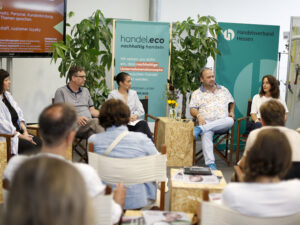PRESS RELEASE
INNATEX international trade fair for sustainable textiles
“Green Fashion is in the midst of a fundamental transformation”
Frankfurt am Main, 22 July 2025 Sustainability today requires more than good intentions – as the 56th INNATEX in Hofheim-Wallau, near Frankfurt am Main, illustrated. Between 19 and 21 July 2025, over 200 Green Fashion brands gathered at the international trade fair for sustainable textiles to present collections for Spring/Summer 2026. On the Sunday in particular the atmosphere surrounding ordering was satisfyingly positive, especially in view of the general challenges in the market.
“While fast fashion is growing, public interest in sustainable fashion has fallen. This is affecting not only retailers like us but the entire supply chain,” says Laura Ott, Buyer at Marlowe green fashion and marketing committee member of the International Association of the Natural Textile Industry (IVN). “We are all entrepreneurs facing similar challenges but our areas of focus and experience vary. Not least, this is a resource that is commercially valuable.”
Reframing long-familiar concepts
Many fashion brands rely on alternative materials that combine a number of benefits. Sloppy Tunas, for example, has collaborated in the development of its own high-tech textile, made in part from collected ocean plastic. The label from Barcelona uses it to make lightweight, quick-drying swim shorts and closes the cycle itself: Worn shorts are taken back and recycled together with offcuts from production to make new yarn and fabric.
The call for innovation and functionality is so loud that well-established textiles which are by their very nature sustainable could slip into the background. Businesses are responding by reintroducing the classic fabrics. Clothing from Berlin-based label Moefe consists of 100% organic cotton. A special knitting technique helps the material keep its shape and makes it stable in shape and stretchy – even without elastic. Mor Khadi, on the other hand, is turning traditional Indian handcraft into modern streetwear. The special qualities of the Khadi fabric give the clothing breathable and thermo-regulating properties.
Legal changes call for adaptability
“The sector is in the midst of a fundamental transformation, caught between Sheinification, the shift to the political right, generation change, digitalisation and increasing price-sensitivity,” says Nina Lorenzen, co-founder of Fashion Changers and a member of the Expert Council Sustainability of the trade journal ‘Textilwirtschaft’. “Companies will remain relevant by being prepared to rethink their business – by turning shopping into an experience, for instance, or reshaping fashion into a statement and a form of protest.”
Dealing with both the latest and pre-existing statutory requirements represents another challenge. By September 2026, the EU member states must transpose the EmpCo Directive (Empowering Consumers for the Green Transition), which came into force in 2024, into national law. Among other things, it regulates how companies may communicate sustainability. Another example affects the processing of leather. The EU is now imposing restrictions on a substance also used for ecological tanning. This will compel manufacturers to change their processes.
“We see a huge need for discussion,” concludes Alexander Hitzel, Project Manager of INNATEX. “Demands on Green Fashion are getting more complex and more dynamic. There is no one simple solution for everyone involved and for all sets of problems. What matters now is that businesses can find precise answers to their specific questions. Platforms that generate ideas and promote cooperation are more important than ever.”
On August 17 and 18, the INNATEX showroom in Bern (Switzerland) will be hosting some 40 brands at the end of the order season.
The next INNATEX takes place from 17 to 19 January 2026.
Print-resolution images: https://innatex.de/presse/?lang=en
Please mark the copyright as specified in the relevant filename.




